affûtage des plaquettes en carbure sont des outils essentiels dans le monde de l'usinage, conçus pour la durabilité et la précision. Mais même les plaquettes en carbure les plus résistantes ont besoin d'être affûtées pour conserver leurs performances. Ce guide complet aborde les détails de l'affûtage des plaquettes en carbure, de la compréhension de leur composition à la sélection de la bonne méthode d'affûtage. Que vous soyez un machiniste chevronné ou un débutant, ce guide vous expliquera tout ce que vous devez savoir.
Aperçu de l'affûtage des plaquettes en carbure
Les plaquettes en carbure sont des composants minuscules mais puissants utilisés dans le travail des métaux, offrant une dureté et une résistance à l'usure remarquables. Ces plaquettes sont fabriquées à partir d'une combinaison de carbure de tungstène et de cobalt, ce qui les rend incroyablement durables. Toutefois, avec le temps, elles peuvent perdre leur tranchant, ce qui nécessite un affûtage pour restaurer leurs performances de coupe.
Pourquoi affûter les plaquettes en carbure ?
L'affûtage des plaquettes en carbure est essentiel pour maintenir leur efficacité et prolonger leur durée de vie. Des plaquettes émoussées peuvent entraîner des coupes de mauvaise qualité, une usure accrue de l'outil, voire des dommages à la pièce. Un affûtage régulier garantit que les plaquettes restent tranchantes, ce qui permet d'obtenir des coupes plus nettes et d'améliorer la productivité globale.
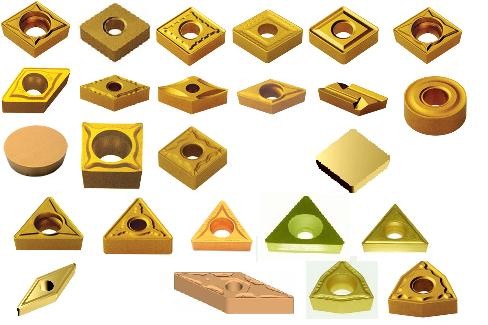
Types d'affûtage des plaquettes en carbure
Il existe différents types de plaquettes en carbure, chacune étant conçue pour des applications spécifiques. Voici un tableau récapitulatif des types de plaquettes en carbure les plus courants et de leurs utilisations :
| Type d'insertion | Description | Application |
|---|---|---|
| CNMG | Angle d'inclinaison négatif, double face | Tournage et fraisage généraux |
| TNMG | Triangulaire, angle de coupe négatif | Ebauche et finition |
| SNMG | Carré, angle de coupe négatif | Ebauche lourde |
| DNMG | En forme de diamant, angle de coupe négatif | Finition soignée |
| WNMG | Trigon, angle de râteau négatif | Dégrossissage moyen à lourd |
| CCMT | Angle de coupe positif, unilatéral | Finition et coupe légère |
| DCMT | Angle de ratissage positif en forme de diamant | Finition de précision |
| VBMT | Rhombique, angle d'inclinaison positif | Finition fine et profilage |
| RCMT | Angle d'inclinaison rond et positif | Contour et profilage |
| APKT | Rectangulaire, angle d'inclinaison positif | Fraisage |
Applications de la Affûtage des plaquettes en carbure
L'affûtage des plaquettes en carbure est essentiel pour divers processus d'usinage. Des applications différentes nécessitent des types de plaquettes et des techniques d'affûtage différents :
| Application | Type d'insertion | Technique d'affûtage |
|---|---|---|
| Tournage | CNMG, TNMG, DNMG | Rodage, meulage |
| Fraisage | APKT, RCMT | Meulage à la meule diamantée |
| Forage | CCMT, DCMT | Rodage à la pâte de diamant |
| Profilage | VBMT, RCMT | Rodage à la main avec des pierres diamantées |
| Dégrossissage | SNMG, WNMG | Meulage avec des meules CBN |
Propriétés des matériaux des plaquettes en carbure
Il est essentiel de comprendre les propriétés des plaquettes en carbure pour choisir la bonne méthode d'affûtage. Voici un aperçu des principales propriétés :
| Propriété | Description |
|---|---|
| Dureté | Extrêmement dur, typiquement 85-92 HRA |
| Solidité | Haute ténacité, résistance à la rupture |
| Résistance à l'usure | Excellente résistance à l'usure grâce à la composition du carbure |
| Stabilité thermique | Maintien de la dureté à haute température |
| Résistance chimique | Résistant à la corrosion et aux réactions chimiques |
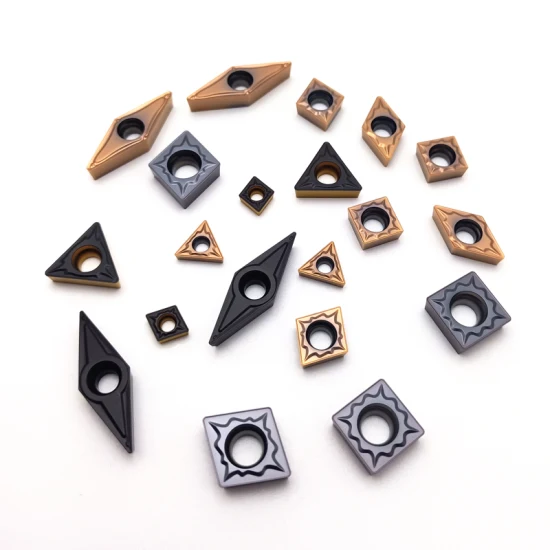

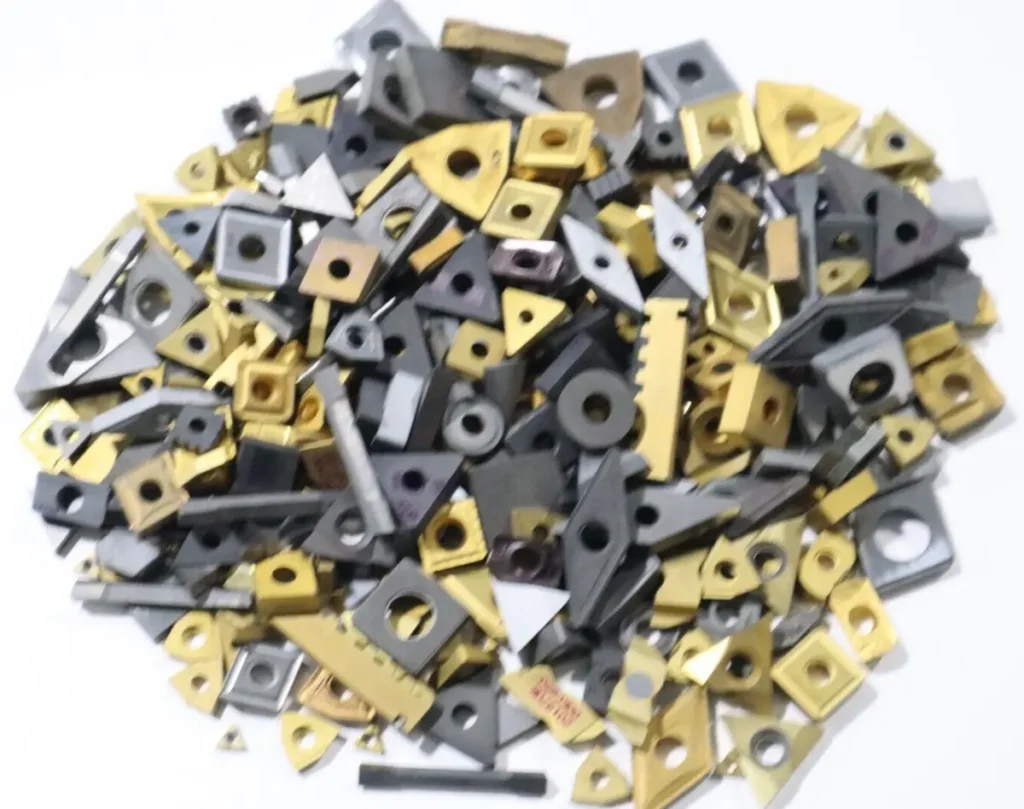
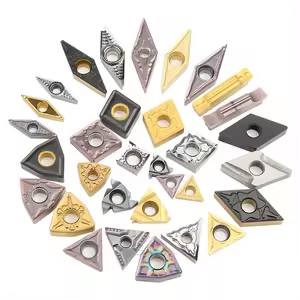
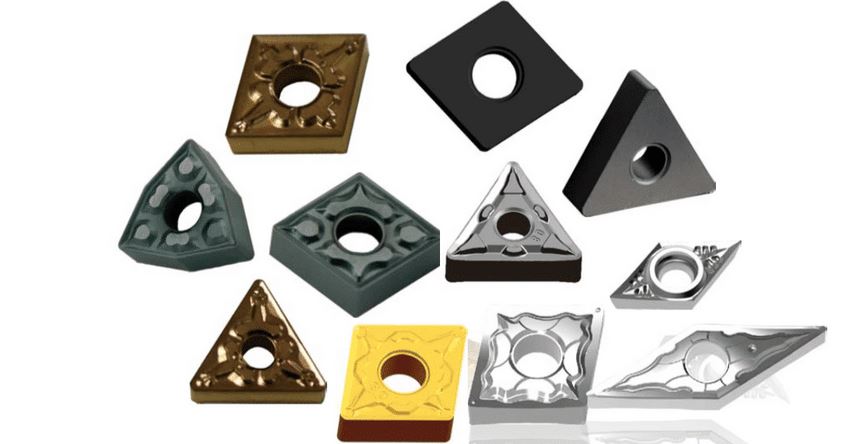
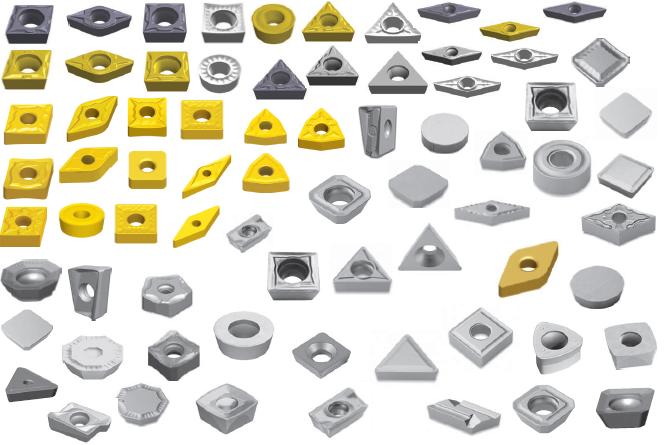
Composition, propriétés et caractéristiques
Les plaquettes en carbure sont principalement composées de carbure de tungstène et de cobalt, chacun contribuant à leurs caractéristiques uniques :
| Composant | Rôle | Caractéristiques |
|---|---|---|
| Carbure de tungstène | Apporte de la dureté | Extrêmement dur et résistant à l'usure |
| Cobalt | Agit comme un liant | Améliore la résistance et la durabilité |
| Carbure de titane | Ajout facultatif | Augmente la dureté et la résistance à l'usure |
| Carbure de tantale | Ajout facultatif | Améliore la ténacité et la stabilité thermique |
Dureté, solidité et résistance à l'usure
Les plaquettes en carbure sont connues pour leur dureté, leur solidité et leur résistance à l'usure impressionnantes. Voici une comparaison de ces propriétés :
| Propriété | Description |
|---|---|
| Dureté | L'indice HRA varie de 85 à 92, ce qui en fait l'un des matériaux les plus durs disponibles. |
| La force | Résistance élevée à la compression, résistance à la déformation |
| Résistance à l'usure | Résistance supérieure à l'usure, idéale pour l'usinage à grande vitesse |
Spécifications, tailles, formes et normes
Les plaquettes en carbure se présentent sous différentes formes et tailles et respectent les normes industrielles pour des performances constantes :
| Spécifications | Détails |
|---|---|
| Tailles | Les tailles courantes comprennent les inserts 1/4″, 1/2″, 3/4″. |
| Formes | Carré, triangulaire, diamant, rond, rhombique |
| Normes | Les normes ISO, ANSI et DIN garantissent la compatibilité et la qualité. |
Fournisseurs et détails des prix
Il est essentiel de choisir le bon fournisseur pour obtenir des plaquettes en carbure de haute qualité. Voici une liste de quelques fournisseurs réputés et leurs tarifs :
| Fournisseur | Localisation | Fourchette de prix |
|---|---|---|
| Sandvik Coromant | Mondial | $5 - $20 par insert |
| Kennametal | Mondial | $10 - $30 par insert |
| ISCAR | Mondial | $8 - $25 par insert |
| Matériaux Mitsubishi | Mondial | $12 - $35 par insert |
| Sumitomo Electric | Mondial | $15 - $40 par insert |
Choisir le bon Affûtage des plaquettes en carbure
Le choix de la bonne méthode d'affûtage dépend de plusieurs facteurs, notamment du type de plaquette, du matériau usiné et de la finition souhaitée. Voici un guide pour vous aider à sélectionner les bonnes plaquettes carbure d'affûtage :
| Facteur | Considération | Méthode d'affûtage recommandée |
|---|---|---|
| Type d'insertion | Rake positif ou négatif | Meulage à la meule diamantée pour une inclinaison négative, honage à la pâte diamantée pour une inclinaison positive |
| Matériau | Dureté et ténacité | Les matériaux plus durs nécessitent des meules diamantées, les matériaux plus tendres peuvent utiliser des meules CBN. |
| Finition souhaitée | Brutalité ou finition | La finition nécessite un honage plus fin, l'ébauche peut utiliser un meulage plus grossier. |
Avantages et limites
Comprendre les avantages et les limites de l'affûtage des plaquettes en carbure peut vous aider à prendre une décision éclairée :
| Aspect | Avantages | Limites |
|---|---|---|
| Performance | Maintient l'efficacité de la coupe, prolonge la durée de vie de l'outil | Nécessite une technique précise, peut prendre du temps |
| Coût | Rentable par rapport au remplacement des inserts | Investissement initial dans l'équipement d'affûtage |
| Polyvalence | Peut être utilisé pour divers processus d'usinage | Limité par le type d'équipement d'affûtage disponible |
Techniques d'affûtage : Comment choisir la bonne méthode
Le choix de la bonne technique d'affûtage est crucial pour maintenir les performances des plaquettes en carbure. Voici un aperçu détaillé des méthodes d'affûtage les plus courantes et de leurs applications :
L'affûtage avec des pierres diamantées
Le rodage à l'aide de pierres diamantées est une méthode précise idéale pour la finition et le profilage. Cette technique consiste à honer manuellement la plaquette à l'aide d'une pierre diamantée à grain fin, ce qui permet d'obtenir un bord tranchant sans enlever trop de matière.
Meulage avec des meules CBN
Les meules CBN (nitrure de bore cubique) sont excellentes pour l'ébauche et l'enlèvement de matière important. Cette méthode utilise une meule CBN pour rectifier la plaquette, ce qui permet d'obtenir une arête vive et de conserver la géométrie de la plaquette.
Meule diamantée
Le meulage à la meule diamantée est une méthode polyvalente qui convient aussi bien pour l'ébauche que pour la finition. Cette technique consiste à utiliser une meule diamantée pour meuler la plaquette, ce qui permet d'obtenir un bord tranchant et durable.
Ponçage à la pâte de diamant
Le rodage à la pâte de diamant est une méthode d'affinage idéale pour obtenir une finition miroir. Cette technique consiste à appliquer de la pâte de diamant sur un outil de rodage et à affûter soigneusement la plaquette, afin d'obtenir un bord tranchant comme une lame de rasoir.
Affûtage des plaquettes en carbure : Guide étape par étape
L'affûtage des plaquettes en carbure nécessite de la précision et les bons outils. Voici un guide étape par étape pour vous aider à démarrer :
- Rassemblez vos outils: Veillez à disposer des outils d'affûtage nécessaires, notamment des pierres diamantées, des meules CBN et de la pâte à honer.
- Nettoyer l'insert: Éliminez les débris ou les accumulations sur l'insert à l'aide d'une brosse douce et d'une solution de nettoyage.
- Fixer l'insert: Placez la plaquette dans un support sûr pour éviter qu'elle ne bouge pendant l'affûtage.
- Choisir la méthode d'affinage: Sélectionnez la méthode d'affûtage appropriée en fonction du type de plaquette et de la finition souhaitée.
- Aiguiser l'insert: Affûter soigneusement la plaquette en maintenant une pression et un angle constants.
- Inspecter le bord: Vérifier la netteté et l'uniformité du bord de la plaquette. Répéter l'opération si nécessaire.
- Nettoyer et stocker: Nettoyez à nouveau l'insert et rangez-le dans un endroit sûr pour éviter de l'endommager.
Comparaison des méthodes d'affûtage : Quelle est la meilleure ?
Les différentes méthodes d'affûtage présentent des avantages et des limites. Voici une comparaison pour vous aider à choisir la méthode la mieux adaptée à vos besoins :
| Méthode | Avantages | Limites |
|---|---|---|
| Pierres de diamant | Précis, idéal pour la finition | Prend du temps, nécessite des compétences |
| Roues CBN | Efficace, bon pour l'ébauche | Peut enlever trop de matière si elle n'est pas utilisée avec précaution |
| Meule diamantée | Bord polyvalent et durable | Nécessite un équipement spécialisé |
| Ponçage à la pâte de diamant | Finition fine, bord tranchant | Idéal pour les petits ajustements, pas pour un affûtage important |
Conseils d'entretien pour l'affûtage des plaquettes en carbure
Un entretien adéquat est essentiel pour garantir la longévité et les performances des plaquettes en carbure. Voici quelques conseils pour maintenir vos plaquettes en parfait état :
- Nettoyage régulier: Nettoyez régulièrement les inserts pour éliminer les débris et les accumulations.
- Stockage adéquat: Conservez les inserts dans un endroit sec et sûr pour éviter qu'ils ne s'abîment.
- Un affûtage opportun: Affûtez les plaquettes dès que vous constatez une baisse de performance afin d'éviter une usure excessive.
- Utiliser des outils de qualité: Investissez dans des outils d'affûtage de haute qualité pour obtenir les meilleurs résultats.
- Moniteur de l'usure: Surveillez l'usure de vos plaquettes et adaptez votre technique d'affûtage en conséquence.

FAQ
| Question | Réponse |
|---|---|
| À quoi servent les plaquettes en carbure ? | Les plaquettes en carbure sont utilisées dans l'usinage pour couper, tourner, fraiser et percer divers matériaux. |
| Quelle est la fréquence d'affûtage des plaquettes en carbure ? | Cela dépend de l'application et du matériau, mais en général, lorsque vous remarquez une baisse de performance. |
| Puis-je affûter moi-même les plaquettes en carbure ? | Oui, avec les bons outils et les bonnes techniques, vous pouvez affûter vous-même les plaquettes en carbure. |
| Quelle est la meilleure méthode pour affûter les plaquettes en carbure ? | La meilleure méthode dépend du type de plaquette et de l'application, mais le meulage à la meule diamantée est une option polyvalente et efficace. |
| Pourquoi les plaquettes en carbure doivent-elles être affûtées ? | L'affûtage maintient leur efficacité de coupe, prolonge la durée de vie de l'outil et garantit des résultats d'usinage de haute qualité. |
Conclusion
Affûtage des plaquettes en carbure est une compétence essentielle pour tout machiniste. En comprenant les différents types de plaquettes, leurs applications et les meilleures techniques d'affûtage, vous pouvez vous assurer que vos outils restent affûtés et efficaces. Que vous affûtiez avec des pierres diamantées ou que vous rectifiiez avec des meules CBN, la bonne approche permettra à vos plaquettes de fonctionner au mieux.




